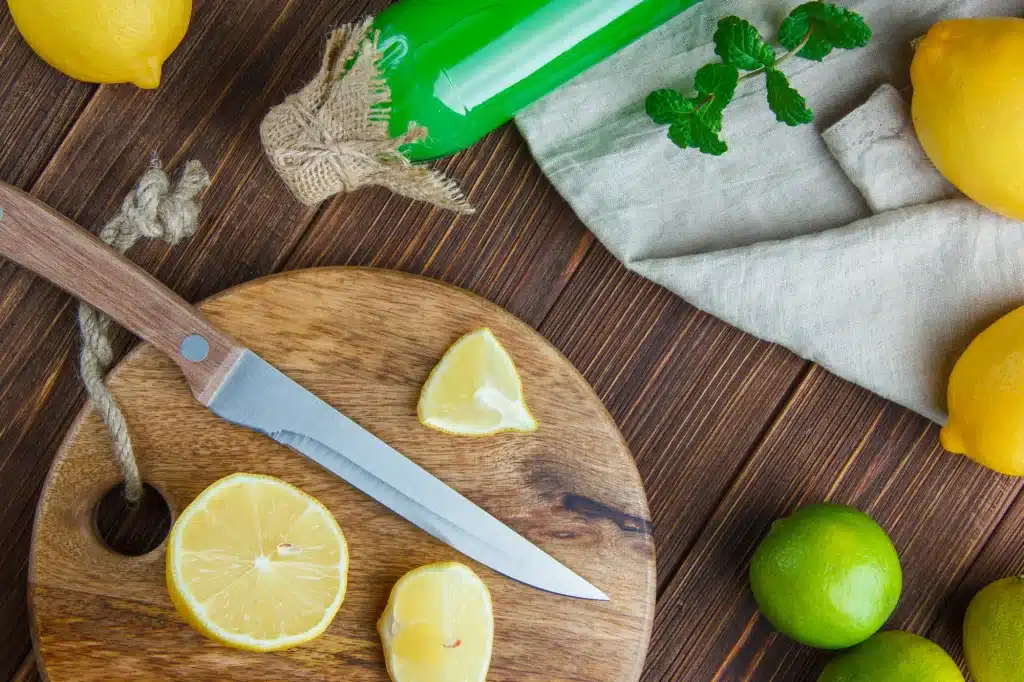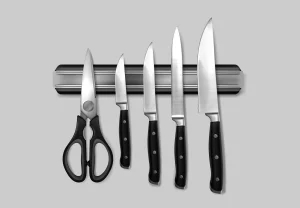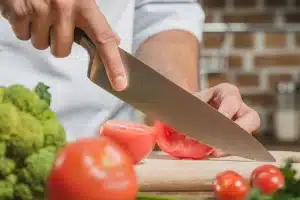Keeping kitchen knives clean and sanitized is essential to ensure food safety and extend the lifespan of utensils. Knives, being continuously used tools in food preparation, can become vehicles for the spread of bacteria if not properly cleaned and disinfected. From cutting raw meat to chopping vegetables, every use exposes the knife to various contaminants that must be removed to prevent cross-contamination and potential health issues.
Regular cleaning also ensures that dirt or food particles do not accumulate, which could dull the knife’s edge, affecting its cutting efficiency. A clean knife not only improves the quality of kitchen work but also helps preserve the original flavors of the food, preventing strong smells from ingredients like garlic or onions from mixing with other products.
When to Clean and Sanitize a Knife?
It is important to understand when it is necessary to clean and sanitize knives to minimize the risk of contamination. Here are some common situations:
- After cutting raw meat, fish, or poultry: Raw meat can contain bacteria such as Salmonella or E. coli, which could transfer to other foods if the knife is not properly cleaned.
- When switching between different types of food: If you’re cutting meat and then switching to vegetables, it’s crucial to clean the knife to avoid transferring bacteria or flavors.
- After being stored for a while: Knives stored for long periods in drawers or knife blocks can accumulate dust or moisture, making them breeding grounds for bacteria.
- After several hours of continuous use: Frequent knife use throughout the day requires periodic deep cleaning.
- When cutting foods with strong odors: Ingredients like garlic or ginger can leave behind intense odors, which, if not removed, will affect the flavor of subsequent ingredients.
Proper Methods for Cleaning and Sanitizing Knives
The process of cleaning and sanitizing knives should be done correctly to ensure that bacteria and residues are thoroughly eliminated. Here’s how to do it:
- Cleaning with hot water and soap: Immediately after use, wash the knife with hot water and soap. Use a soft cloth or sponge to scrub both sides of the blade and the handle.
- Disinfecting with appropriate solutions: After washing with soap and water, it’s recommended to immerse the knife in a mild disinfecting solution (a mixture of water and bleach in low concentrations is very effective). Leave the knife in the solution for at least 30 seconds, then rinse it with clean water.
- Proper drying: It’s crucial to thoroughly dry knives after washing them. Moisture can encourage bacterial growth and damage the blade, especially if it’s made of carbon steel, which could lead to rust.
This method ensures that knives remain not only clean but also free from harmful bacteria that could pose a health risk to those consuming the food.
Benefits of Keeping Knives Clean and Disinfected
Proper knife cleaning not only ensures food safety but also offers several additional benefits:
- Prevention of cross-contamination: A contaminated knife can transfer bacteria from one food to another, which is especially dangerous when handling raw and ready-to-eat foods, like salads.
- Improved food quality and taste: A clean knife preserves the integrity of flavors, preventing strong smells from previously cut foods from mixing with other products.
- Extended lifespan of the knife: Proper cleaning removes residues that could build up on the edge, keeping it in better condition for longer.
- Overall kitchen hygiene: Keeping knives and other utensils clean improves the working environment and reduces the risk of foodborne infections.
Risks of Not Properly Cleaning Knives
Using knives without proper cleaning can lead to several risks that should not be underestimated. The main problems include:
- Cross-contamination: Using a knife that hasn’t been cleaned properly can transfer bacteria from raw foods (meat, fish) to foods eaten raw, like salads or fruits. This can cause illnesses such as Salmonella or E. coli.
- Bacteria build-up on the blade: A poorly cleaned knife can accumulate food particles and bacteria on its edge, compromising both food safety and cutting efficiency.
- Knife corrosion and deterioration: Failing to clean knives properly, especially those with steel blades, can lead to corrosion, weakening the material over time and affecting its performance.
How to Store Knives After Cleaning?
After cleaning and disinfecting a knife, proper storage is essential to ensure it remains in optimal condition. Here are some tips:
- Store them in a knife block or on a magnetic strip: Both methods ensure that knives are kept in a clean and dry place. Avoid storing them in drawers where they could get damaged or come into contact with dirty surfaces.
- Use protective sheaths: If you don’t have a knife block, a sheath for the blade can protect the edge and keep it clean until the next use.
- Make sure they are completely dry before storing: Moisture is one of the main causes of knife rust. Ensure they are thoroughly dry before putting them away.
Cross-Contamination: The Invisible Enemy in the Kitchen
One of the biggest risks of not cleaning knives is cross-contamination. This occurs when bacteria from one food, especially raw meat or chicken, are transferred to other foods by using the same knife without cleaning it first. For example, if a knife is used to cut raw chicken and then used to cut vegetables without being cleaned, the bacteria can transfer, potentially causing infections.
Recommended Products for Cleaning and Disinfecting Knives
To achieve effective cleaning and sanitizing of knives, it’s recommended to use specialized products or equally effective homemade methods:
- Hot water and mild soap: This is the most basic and recommended method. The soap should be mild to avoid damaging the knife’s edge.
- Diluted bleach: A small amount of bleach (about a teaspoon per liter of water) can be used to disinfect knives after washing them with soap.
- Commercial disinfectant solutions: There are commercial disinfectant products designed specifically for kitchen utensils. Make sure they are safe for food contact.
The Role of Temperature in Knife Sanitization
Temperature plays a crucial role in knife sanitization. Washing with warm or hot water is more effective than using cold water, as the heat helps eliminate grease and food residues more quickly. Additionally, hot water combined with a proper detergent facilitates the destruction of bacteria and other microorganisms. However, it’s important not to expose knives to extreme temperatures, as this can damage the edge or handle materials.
Practical Tips for Prolonging the Lifespan of Your Knives
- Clean the knife immediately after use: This prevents residues from sticking to the blade, making cleaning easier.
- Avoid using dishwashers: Knives should be washed by hand, as dishwashers can damage them due to high temperatures and harsh chemicals.
- Sharpen your knives regularly: A sharp knife is more efficient and safer. Regular sharpening prolongs its lifespan.
- Avoid hard surfaces: Cutting on hard surfaces like glass or ceramic can damage the knife’s edge. Use wooden or plastic cutting boards.
Can You Wash Knives After Sharpening Them and How to Do It?
Yes, it’s recommended to wash knives after sharpening. During the sharpening process, small metal particles can remain on the blade, which should be removed before using the knife to avoid contaminating food.
How to Wash a Knife After Sharpening?
- Initial Rinse: After sharpening the knife, rinse it with warm water to remove any loose metal particles that may remain on the edge.
- Clean with Soap and Water: Wash the knife with hot water and soap, using a soft sponge or cloth. Gently scrub both sides of the blade to ensure that any metal residues and oils from handling are removed.
- Final Rinse: Make sure to thoroughly rinse the knife to remove all soap and any remaining particles. It’s important not to leave any residue that could affect cutting quality or hygiene.
- Dry Completely: Immediately dry the knife with a clean cloth, paying close attention to the blade and handle. It’s essential to remove all moisture, especially for carbon steel knives, which can rust.
This process ensures that the knife is clean, free of particles, and safe to use in the kitchen.
Can Washing Dull a Knife’s Edge?
No, washing does not dull a knife’s edge. However, certain improper washing or handling habits can affect the sharpness over time. Here are some factors to avoid to protect the edge during washing:
- Avoid Dishwashers: Knives should never be washed in the dishwasher. The contact with other utensils, high temperatures, and harsh detergents can damage both the blade and the handle.
- Use Soft Sponges: Use soft sponges or cloths to wash the knife. Avoid using abrasive materials, as they can scratch the knife’s surface or slightly wear down the edge.
- Don’t Soak the Knife for Long Periods: Soaking knives in water for too long can deteriorate the materials, especially if the blade is made of carbon steel, as this promotes corrosion, which can eventually weaken the edge.
- Proper Drying: It’s important to dry the knife immediately after washing. Prolonged moisture can rust the metal, especially on carbon steel knives, which may affect the edge over time.
If the knife is washed properly, its edge will remain sharp, and its efficiency will be preserved. The key is to use the correct washing and storage methods to extend the knife’s lifespan.
Maintaining clean and sanitized knives is not only essential for food safety but also improves efficiency in the kitchen and extends the lifespan of these indispensable tools. Cross-contamination and bacteria build-up can have serious health consequences if proper measures are not taken. By following correct cleaning and storage practices, a safer working environment is ensured, food flavors are preserved, and unnecessary risks are avoided. Hygiene in the kitchen should always be a priority.





